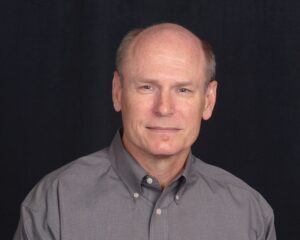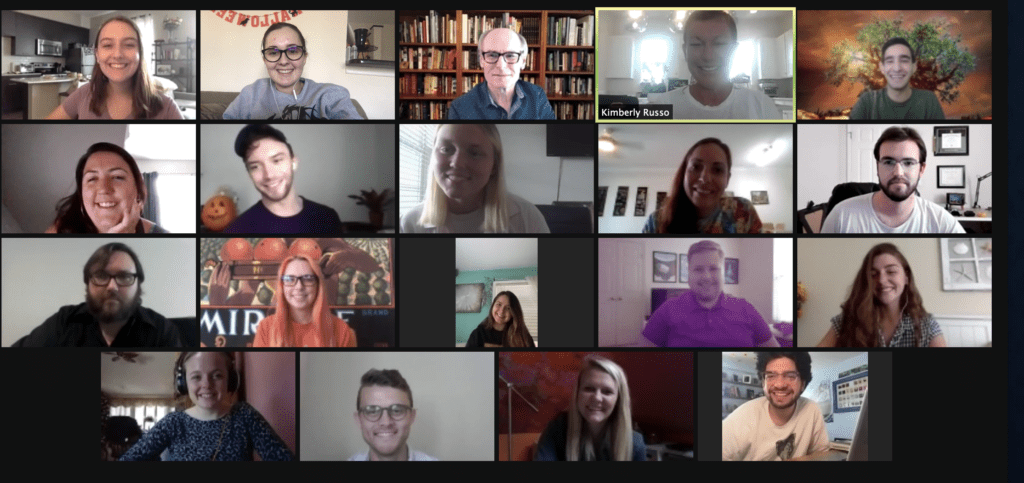Former Disney Imagineer Steven Grant leads new Themed Environments Integration program at UF Orlando CityLab
Interview by Judith Rubin
ABOVE: Students met in person prior to switching to an online course due to the pandemic. All photos courtesy of Steven Grant.
There’s a new themed entertainment academic program in town! In August 2019, the first cohort of 14 students began their studies in the Master of Science in Architectural Studies Concentration in Themed Environments Integration (MSAS|TEI), or Graduate Certificate in Themed Environments Integration (GC|TEI), part of the University of Florida’s CityLab-Orlando, located downtown. In August 2020, the second cohort of 20 students began their studies in the program. (More info at https://dcp.ufl.edu/tei/)
I was fortunate to be in Orlando in January 2020 for a first-hand experience of this program thanks to Program Director Steven Grant AIA who took the time to show me around, explain the curriculum and let me sit in on an in-person class (things have since moved online due to the pandemic). Grant stepped into the role on the heels of a 28-year tenure at Walt Disney Imagineering. — J.R.
Please share some background on the development and structure of the TEI program.

UF CityLab-Orlando was founded by the College’s School of Architecture as an off-campus program offering the Master of Architecture degree. The program began operation in fall 2012. In 2018 the College actively began the process of developing the certificate and master’s degree programs in Themed Environments by engaging industry leaders to help identify the knowledge, skills and abilities needed in the industry. From those meetings emerged the underlying principles for the program and its exclusive focus on the process of developing themed environments.
The TEI program is interdisciplinary. The TEI student body is made up of students with undergraduate degrees in planning, real estate, architecture, theater, film, interior design, recreation, park & tourism management, communications, hospitality, international studies, mechanical and civil engineering, and political science. The diversity of knowledge and perspectives that our students bring to the program supports engaging conversations and a sharing of knowledge.
In your experience, how does being a working architect in themed entertainment differ from a more traditional practice of the discipline?
Before I was an Imagineer, I had worked in five architectural firms, from the largest AE firm in the world at the time – Skidmore, Owings & Merrill – to small practices in Chicago, New York, and Tucson.
Architects often lead project teams in traditional practice. Architecture is one of the many disciplines that support the design and development of themed environments but is not the dominant discipline. The leadership in the design and development of themed environments (especially theme parks) is show-based. If you are good at being a supporting cast member, and not the star, it can be – and was for me – an enriching experience.
Themed environment project teams include disciplines that are not usually part of a traditional architectural project: i.e., artists, writers, theater technical arts. Because of the complexity of the design of themed environments the focus of the TEI program is collaboration (people) and integration (systems).
Are many of your students architects?
About one-third of our students are studying architecture. They are either studying for their Master’s Degree in Architecture, and taking TEI classes to obtain a Graduate Certificate in Themed Environments Integration, or they already have a Master’s Degree in Architecture and have returned to school to focus on themed environments.
How are you training students to understand and function well in this team-oriented, interdisciplinary, show-dominated culture of attraction development?
Multi-discipline teams come up with creative designs and solutions to problems. That is why our classes are made up of students with diverse backgrounds and disciplines. The classes are engaging and fun. The students are learning from each other. This provides them with experience working on interdisciplinary teams that they will be a part of when they are in the industry.
Professionals are often trained in silos. That is not how actual practice works. So, we are providing an interdisciplinary learning environment. When you give a diverse team of students a problem to solve, they will always come up with a more creative solution than a team made up of one discipline. They use their diverse perspectives and training to solve it.
Tim Brown in his book Change by Design provides a good description of our goal: “Design thinkers…cross the ‘T.’ They may be architects who have studied psychology, artists with MBAs, or engineers with marketing experience. A creative organization is constantly on the lookout for people with the capacity and – just as important – the disposition for collaboration across disciplines. In the end, this ability is what distinguishes the merely multidisciplinary team from a truly interdisciplinary one.” The objective of our program is to provide the industry with these types of professionals.
I have been able to reach out to my many friends and colleagues in the themed environments industry for advice on curriculum content and to be guests in my classes. During the first year of the program the students were able to hear from and meet 55 industry professionals during class, and on facility tours. Only in Orlando is this possible!
How do the students balance team culture training with focusing on their chosen specialty?
Our students come into the program with an undergraduate degree. Our intent is not to train them in a new discipline but to provide them the education needed to supplement their existing degree so they can be effective integrators and collaborators in the themed environments industry.
We do this by providing them an overview of the Themed Environment Industries, including design and delivery processes, collaboration practices and systems, interrelated disciplines, systems, tools, codes, and standards and fabrication and execution practices. These are explored through reading, writing, team projects, guest speakers, project tours, research, and internship.
Sometimes a student will decide to change focus as a result of what they discover about the industry in the course of the program. We do what we can to help and advise them in such areas as internships and the choice of thesis project.
How do the Orlando location and your background enrich what the program can offer students?
Orlando includes more people and industries that support the global themed environments industry than anywhere else, designing and building theme parks, hotels, resorts, restaurants, and retail around the world. This includes theme park operators and owners with in-house design teams, project management and design companies, fabrication companies, and architecture, engineering, planning, landscape architecture and construction companies.
At Imagineering I worked on many teams as an architect and design manager. I stress to my students that the most important skill you bring to a project is your ability to work on teams. The projects are complex, and the teams are large.
TEI has two advisory committees that represent the above industries: the curriculum advisory board and the professional advisory committee. The members of these boards are the best in the industry. The TEI program is a merger of the University of Florida’s academic and research resources with Orlando’s broad themed environments industries expertise.
Tell us a little more about your own background.
I grew up in the Midwest. Disneyland was a faraway place. What I remember about the family vacation to Disneyland in 1965 was riding in the backseat of my family’s non-air-conditioned Rambler across the deserts of the West. Working for Disney would not have been a thought. I had never heard of Walt Disney Imagineering in 1990 when my friend and mentor in Chicago saw a wanted ad from the company in California and suggested that we apply. I applied; four months later I sold my house and moved my family to Glendale, California to work for WDI.
You had to transition to remote teaching due to the pandemic. Have you found it necessary to alter the curriculum or your approach? How are the students responding?
It has been a challenging year, but I think it has gone well. I had only been teaching for seven months when I had to transition to online teaching. It was just another challenge to add to the others. Since the TEI program is focused on collaboration, I was concerned that the new students would not get to know each other as quickly as the first cohort did, but they have.

The August 2020 cohort met regularly online instead of in person.
Zoom has its benefits. The breakout room function is one them. I can separate the class into smaller groups each week to discuss a team project or focus paper, and then return to the class to present their designs or position on a subject.
The TEI curriculum includes an interdisciplinary project development studio in the summer. Since this was our first summer studio, and it was online, we explored “collaboration over distance.” Prof. Stephen Bender and I led the class. The Project Development Studio explored how to improve collaboration over distance, resulting in a better shared experience. We explored collaboration at a city scale to the personal scale of sitting in front of a computer at home. The students learned a lot, but it also provided us with lessons learned that we have been able to incorporate into our fall classes.
Our students have wanted to be in the themed environments industry since they were young. They grew up attending theme parks and knowing that there are people who actually design and build them, so the opportunity to study themed environments for them has been a desire for years. Whether the classes are in-person or over distance they are excited to be in the program.






